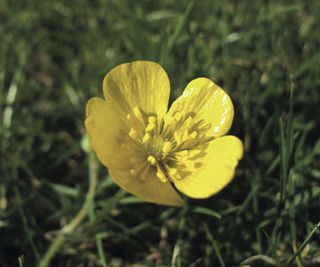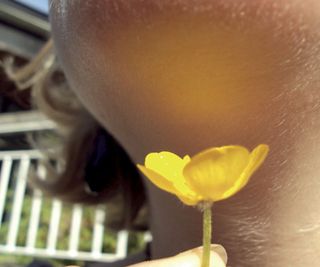Secret to Buttercups' Yellow Spotlight Revealed

Children have long known that if you hold a little buttercup flower under your chin on a sunny day, the underside of your chin will be bathed in a yellow light.
Now, by examining the petals of one species of buttercup, Ranunculus repens, scientists have figured out how the flower manipulates light to make this child's trick possible.
Research dating back to 1883 has noted the buttercup's unusual optical properties. But this is the first time scientists have studied the flower's light-reflecting qualities with modern equipment and related them to the anatomy of its petals, according to study researcher Ullrich Steiner, a professor of physics at the University of Cambridge in the United Kingdom.
Petal anatomy
Using flowers picked from meadows around Cambridge, the researchers — both physicists and plant biologists — examined the petal and the layers within it, and how these layers affected the wavelengths of light passing through or reflecting off them.

Their examination revealed how the anatomy of the petal creates the yellow glow — which, according to children's lore, indicates the chin's owner likes butter.
It turns out that light arriving at the flower petal encounters two different surfaces within its outer layer, called the epidermis. Both surfaces are flat — the lower one borders an air gap — and each reflects light back much like a mirror would. This means that the angle at which the light travels to the surface equals the angle at which it travels out, so all of the reflected light travels in the same direction. [Gallery of Mysterious Lights]
Sign up for the Live Science daily newsletter now
Get the world’s most fascinating discoveries delivered straight to your inbox.
These surfaces give the flower its glossy appearance.
The epidermis also contains pigment that absorbs the wavelengths of light associated with the blue part of the visible light spectrum. The other wavelengths are reflected back to our eyes and are perceived as the color yellow.
The light that does make it through both of the surfaces of the epidermis and the air-filled gap finally arrives at a layer of starch. This layer reflects the arriving wavelengths of light back equally, much like white paper would. But because the reflected light must travel through the pigment twice (once on the way in, once on the way out), it gives rise to the strong yellow color, Steiner said.
Out in the meadow
Steiner and his colleagues, including plant biologist Beverly Glover of the University of Cambridge, suspect that the buttercup's ability to manipulate light this way comes in handy out in the meadow.
"Suppose you have a meadow full of different flowers, and each one wants to be pollinated by a bee, a bee has a lot of choices, so each one of the flowers tries to stand out in their own way," Steiner said. "Here you have a flower that can send a flash of light at a bee."
This spotlight of reflected yellow light flashes at the bee as it travels along its path or as the wind moves the flower, Steiner speculates.
Supporting this theory, the researchers found that the flower petals had the same glossy appearance under ultraviolet light. Light at these wavelengths is not visible to humans, but is an important cue for insects, including bees.
The research was published Wednesday (Dec. 14) in the Journal of the Royal Society Interface.
You can follow LiveScience senior writer Wynne Parry on Twitter @Wynne_Parry. Follow LiveScience for the latest in science news and discoveries on Twitter @livescience and on Facebook.
Most Popular


